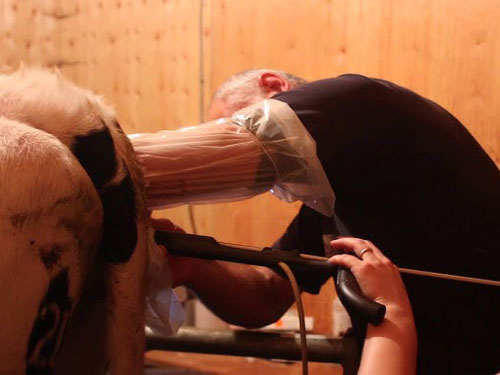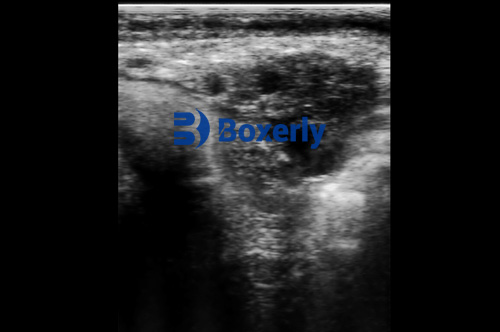As a livestock manager, optimizing reproductive efficiency is the cornerstone of profitable cattle production. Precise determination of pregnancy status and fetal age enables informed decisions on culling non-pregnant cows, resynchronizing breeding females, and grouping herds strategically. Among available methods—manual palpation, blood tests, and ultrasound—Veterinary ultrasound (transrectal ultrasonography) has emerged worldwide as the most precise, non-invasive, and informative approach. In this article, we explore how ultrasound pregnancy screening enhances breeding decision accuracy by referencing notable international studies and real‑world farming experiences.

1. Methods of Pregnancy Diagnosis: Positioning Ultrasound
Veterinary pregnancy diagnosis techniques include:
Manual rectal palpation, a long‑standing method viable from ~35–45 days post‑breeding, but requiring skilled practitioners and posing moderate risk to fetus and dam.
Blood or milk PAG (pregnancy‑associated glycoprotein) tests, which are non‑invasive, available as on‑farm rapid tests from about 28 days post‑breeding, though they may give false positives when tested too early post‑partum.
Ultrasonography, which detects viable embryos by visualizing heartbeat and fetal structures from ~28–30 days onward, with precision improving by 30–40 days.
2. Accuracy and Precision of Ultrasound Screening
International research consistently demonstrates high accuracy of ultrasound screening:
Detection rates: Studies show >95% sensitivity for early detection at 30 days post‑AI. At days 20–22 with color‑Doppler targeting the corpus luteum, accuracy reaches 85–100%.
Age estimation: Experienced technicians can estimate fetal age within ±10 days up to ~90 days gestation.
Viability & sexing: Fetal heartbeat detection confirms viability. Sexing accuracy of >95% is reported between days 60–85.
Fetal abnormalities: Ultrasound identifies twins, embryonic loss, ovarian cysts, and uterine pathologies that palpation might miss.
Overall, ultrasonography is widely regarded as one of the most dependable diagnostic methods when performed by experienced personnel.

3. Why Ultrasound Enhances Breeding Decisions
3.1 Earlier and Better Culling Decisions
Culling non-pregnant cows early saves substantial feed and labor costs:
In Canada, early identification and removal of open cows in fall avoids unnecessary winter feed expenses.
A U.S. report emphasized that open cows cost farmers feed and opportunity—pregnancy checks and culling open cows can offer strong seasonal economic advantage .
3.2 Grouping by Calving Date
Ultrasound fetal aging allows grouping pregnant cows into early/late calving cohorts:
This improves target feeding (e.g., Sandhills method) and calf uniformity.
Producers can position late-calving cows separately, reducing stress and pathogen exposure on newborns.
3.3 Re-synchronization and Rebreeding
After AI programs:
Ultrasound pregnancy checks at ~28 days allow open cows to be quickly re‑synchronized and service‐ready again.
Color‑Doppler diagnosis at ~20 days post‑AI enables tight resynchronization cycles (~24 days), enhancing overall pregnancy rates.
3.4 Assessing Reproductive Soundness
Ultrasonography often uncovers sub‑fertility issues:
Ovarian cysts, uterine infections, ovarian non‑viability, or twin pregnancies can be detected early .
This helps isolate genetic or health issues; low conception rates can prompt semen quality or AI technique reviews.
4. Financial Implications and ROI
Studies show ultrasound screening reduces total herd feed costs and improves profitability:
UNL BeefWatch confirms early checking avoids feeding open cows and reduces calf health problems.
Canadian economic modeling suggests fall checking plus targeted feed strategies yields best returns in high feed‑cost seasons.
Timely culling of non‑pregnant cows enhances sale price and reduces overwinter losses.
5. Implementation: Tools and Training
5.1 Ultrasound Equipment
Two probe styles are common:
Linear rectal probes – high-frequency, high resolution, preferred for early detection and fetal sexing.
Convex rectal probes – lower frequency, larger scanning area, useful on extension-arm setups for large herds.
Advances include sunlight-readable screens, wireless displays, and head-mounted goggles—enhancing ergonomics under field conditions.
5.2 Technician Expertise
Skill level directly affects accuracy:
Experienced veterinarians can achieve >95% detection accuracy by 30 days.
Training is crucial: specialized ultrasound courses are widely available .
Even moderately experienced operators benefit, especially when compared to manual palpation.
5.3 Protocol Integration
A practical herd-level protocol might look like:
Define breeding season and AI timeline.
Perform transrectal ultrasound at 28–35 days post-AI/breeding.
Confirm fetus viability (heartbeat, presence).
Age fetus and separate early-calving vs late-calving groups.
Resynchronize/open‑cow group immediately.
Retest late-imaged or uncertain cows at ~45 days if necessary.
Color‑Doppler may enable even earlier detection and faster management actions.

6. Global Adoption and Research
Ultrasound pregnancy screening is widely used in North America, Australia, Europe, and Japan:
Australia (Victoria): ultrasound is used to diagnose fertility, estimate calving dates, and manage culling decisions.
U.S.: guidelines from UF/IFAS and UNL report >95% accuracy and emphasize fetal aging, resynchronization, and economic benefits.
South America (Brazil): color‑Doppler programs publicly report >90% accuracy in early pregnancy detection and improved pregnancy rates .
7. Challenges and Limitations
Equipment cost: high-quality ultrasound units are expensive; returns depend on herd size and labor savings.
Skill-related losses: incorrect interpretation may cause false positives/negatives; rigorous training reduces this.
Animal stress: handling and restraint can cause minor fetal loss (~1–3%) when done early.
Postpartum timing: blood tests give false positives if postpartum intervals are too short; ultrasound avoids this issue.
8. Case Study Snapshot
A 500-head U.S. commercial herd implemented:
AI + cleanup bull for 45 days.
Ultrasound checks at 30 days.
Early-calf and late-calf groups were segregated; open cows re-synchronized at 24 days.
Results:
62% first‑cycle conception; an additional 24% in second cycle.
Open cows trimmed feed costs and were marketed at higher fall prices.
Fetal sexing used to create heifer-specific rearing groups—a premium revenue stream during herd expansion.
Overall reproductive rate improved by ~10% in one year, with ROI realized within two seasons.
9. Summary of Key Benefits
| Benefit | Description |
|---|---|
| Precision pregnancy detection | 95% accurate from ~30 days; viability, twin detection, fetal sexing |
| Targeted breeding decisions | Promptly identify open cows; cost savings via early culling |
| Group management | Age-based herd structuring; reduced calf illness |
| Enhanced resynchronization | Tight AI cycles; improved fertility results |
| Reproductive health insight | Early detection of fertility issues and irregularities |
| Economic gains | Feed cost savings, premium market prices, efficient use of resources |

10. Recommendations and Next Steps
To adopt ultrasound pregnancy screening effectively:
Define your breeding window clearly.
Invest in or lease quality ultrasound equipment suitable for herd size.
Train or partner with skilled veterinarians or technicians.
Establish a consistent pregnancy‑checking schedule around 30–35 days post‑breeding.
Implement action plans: early culling, re-synchronization, feed-group reallocation.
Collect and review data on pregnancy rates, feed usage, and weaning weights yearly.
Adjust management strategies using insights on fertility patterns, breed or nutrition adjustments.
Conclusion
Veterinary ultrasound pregnancy screening has revolutionized precision breeding management in modern cattle operations. Its combination of early detection, accuracy, and comprehensive information empowers decisions that enhance fertility, productivity, animal welfare, and profitability. From North American ranches to Australian herds and European farms, ultrasound has become indispensable in optimizing breeding outcomes. By integrating ultrasound into herd reproduction protocols, producers gain a clearer window into reproductive status—and a stronger foundation for making economically sound, data‑driven choices.
References
BeefResearch.ca – “Pregnancy Detection in Beef Cattle“
UT Beef Univ Tennessee – “Pregnancy Diagnosis in Beef Cattle”
UF/IFAS – “Practical Uses for Ultrasound in Managing Beef Cattle Reproduction”
SAGE Journals – “Role of Transrectal Sonography…”
Western Producer / Farm Progress – “Pregnancy checks require accuracy”; “Accuracy matters…”
UNL BeefWatch – “Can early pregnancy detection help…”
SciDirec & Repro‑Scan – technical equipment guidance
PubMed J Dairy Sci – Fricke 2002 review on ultrasonography
BovineVetOnline – practical perspective
tags:


